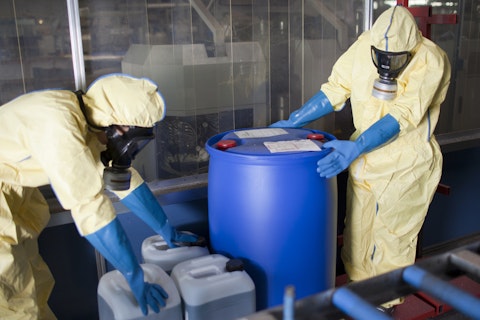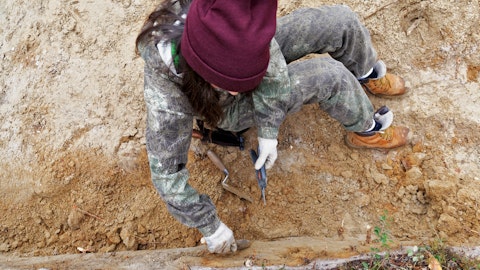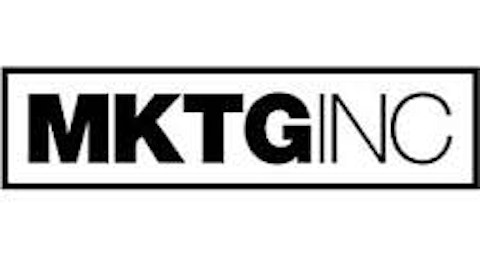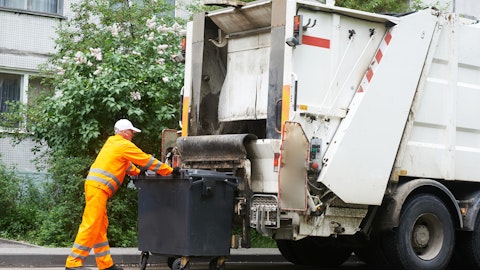Perma-Fix Environmental Services, Inc. (NASDAQ:PESI) Q4 2022 Earnings Call Transcript March 24, 2023
Operator: Good day, everyone and welcome to the Perma-Fix Fiscal 2022 Year End Earnings Conference Call. It is now my pleasure to turn the floor over to your host, David Waldman. Sir, the floor is yours.
David Waldman: Thank you, Matt. Good morning, everyone and welcome to Perma-Fix Environmental Services fourth quarter and year end 2022 conference call. On the call with us this morning are Mark Duff, President and CEO; Dr. Lou Centofanti, Executive Vice President of Strategic Initiatives; and Ben Naccarato, Chief Financial Officer. The company issued a press release this morning containing fourth quarter 2022 financial results, which is also posted on the company’s website. If you have any questions after the call or would like any additional information about the company, please contact Crescendo Communications at 212-671-1020. I’d also like to remind everyone that certain statements contained within this conference call maybe deemed forward-looking statements within the meaning of the Private Securities Litigation Reform Act of 1995 and include certain non-GAAP financial measures.
All statements on this conference call other than a statement of historical fact are forward-looking statements that are subject to known and unknown risks and uncertainties and other factors, which could cause actual results and performance of the company to differ materially from such statements. These risks and uncertainties are detailed in the company’s filings with the U.S. Securities and Exchange Commission as well as this morning’s press release. The company makes no commitment to disclose any revisions to forward-looking statements or any facts, events or circumstances after the date hereof that they are upon forward-looking statements. In addition, today’s call will include references to non-GAAP measures. Perma-Fix believes that such information provides an additional measurement and consistent historical comparison of its performance.
A reconciliation of the non-GAAP measures to the most directly comparable GAAP measures is available in today’s news release on our website. I’d now like to turn the call over to Mark Duff. Please go ahead, Mark.
Mark Duff: Alright. Thanks, David and good morning everyone. 2022 was a transformative year as we built a solid foundation for growth in the upcoming year and we are finally seeing a return to normalization and the momentum we had prior to the pandemic. The weakness in revenue we experienced in 2022 was due to the lingering effect of the COVID-19 pandemic on delaying some of the projects in the services and the treatment segments. Nevertheless, we have achieved a 58% increase in gross profit in the fourth quarter, which was due to improved profitability in the services projects compared to last year. In addition, total gross profit margins increased from roughly 7% to 12%. While 2022 was a challenging year, we believe we are back on the growth trajectory, primarily due to the recent improvement we have seen in our Treatment segment.
Within our Treatment segment, we have experienced a steady improvement in waste receipts. Specifically, our average receipts per quarter have steadily returned to pre-pandemic levels over the last 9 months of the year. This is best reflected in our backlog, which is $9.2 million at year end, significantly higher than prior quarters. This was a result of increased waste shipments from DOE as well as our efforts to broaden our client base into the commercial utility sector as well as oil and gas and other industrial markets. It’s important to note that the fourth quarter of 2022 was negatively impacted by challenges associated with labor issues and high attrition rates due to the Department of Energy hiring campaigns at several other sites, which are near our facilities as well as supply chain impacts from availability of waste processing materials such as grout mix.
We also experienced severe weather impacts due to record low temperatures in the Tri-Cities area of Washington. However, these issues have begun to subside in the first quarter of 2022 excuse me, first quarter of 2023, with hiring at each location realizing stability compared to the last two quarters. In addition to the growth of our base business, we are rapidly advancing several initiatives that we believe have the potential to significantly enhance our revenues and our long-term backlog. For instance, we have realized two important steps forward with the Department of Energy in pursuit of our Hanford initiatives that hold significant potential growth for many years. These initiatives include the January 31 amendment of the Record of Decision, or ROD, for the final tank closure waste management EIS that was originally developed in 2013 as well as an announcement this past Friday for the notice of availability for the waste incidental to reprocessing, what we call, the WIR report, which is in support of the test bed initiative demonstration what we call TBI.
First, I will touch base on the first amendment the amendment to the ROD for the direct feed low activity, which we’ll refer to as the DFLAW facility, supports the secondary waste program also at the Hanford site in Washington represents a sizable opportunity over the next decade. And while we can’t provide too many specifics at this time, suffice to say that Perma-Fix will provide the recommended treatment solutions for radioactive waste streams are produced by the DFLAW program once it gets operational. This waste is estimated by DOE to be over 8,000 cubic meters annually. We will be begin to be received at Perma-Fix facilities upon a hot startup of the plant currently projected to begin in the late 2024 timeframe. To put this in perspective, this volume of waste would more than double the production of all of our plants combined on an annual basis.
And given the fixed cost nature of our business, this could result in the very significant cash flows over the next 10-year period. The second step forward, as I mentioned, is the final waste incidental to reprocessing or WIR document published this week by DOE, which states that the program of the proposed TBI program would demonstrate a supplemental law treatment approach. The WIR went on to state that based on the final evaluation, DOE determined that the pretreated and solidified waste from the tanks is incidental to reprocessing of spent nuclear fuel is not high level waste and is to be managed as low level waste. This progress opens the door for DOE to work with the Washington State Department of Ecology, which is a regulator to develop and approve the regulatory documents for shipment of the Phase 2 program.
The Phase 2 includes grouting disposal of 2,000 gallons of tank waste currently anticipated to be shipped before the end of the year. These developments underscore the important role that Perma-Fix will be playing in the long-term mission for Hanford closure in support of both the DFLAW vitrification program as well as the supplemental take waste treatment program that will likely include commercial grouting. As discussed last quarter, the TBI initiative holds the potential to save tens of billions of dollars, taxpayer dollars as well as eliminate significant carbon emissions and reduced schedules for Hanford cleanup. Perma-Fix maintains these capabilities today at our Perma-Fix Northwest facility, which is permitted now fitted to safely and compliantly grout up to 30,000 gallons a month, with the ability to expand well over 1 million gallons annually while dramatically reducing cost compared to vitrification.
Within the Services segments, we reached full operational status in several projects that have been delayed due to the impact of the pandemic. And additionally, we have secured important new projects that we expect will begin in the second quarter of 2023. As the impacts from the pandemic continue to fade, the federal government has begun to announce new projects that have been on hold. These procurement cycles are moving forward to support the increased funding levels, which we anticipate will result in a number of additional opportunities to be awarded in the coming quarters. As a result, we have now over $200 million in defined procurement opportunities targeted to be released in the next few quarters. In addition, we continue to await some very large potential strategic awards by the DOE.
Some of these projects are quite considerable in size and if selected by DOE would represent substantial increases into sustainable revenue to align with our core competencies. Some of these upcoming DOE project announcements include the $45 billion Hanford integrated tank disposition contract and the $3 billion operation to site mission support project, which are both likely to be awarded in the second quarter. If we are successful, we would participate as a team member on these large deal procurements, both of which completely align with our strengths and innovations and radiological protection and waste management, we are also close to announcement of another project that we referred to in past calls through the Joint Research Council in Italy, which this project would support our expansion program in Europe and open the door for deployment of our treatment technologies in these rapidly growing markets in Europe.
We have also received several strategic awards over the past few months, specifically associated with our sole solar technology, including announcement last week that our team was awarded the first abandoned uranium mine closure task order in support of the new EPA abandoned mine program. While this initial task order represents only about $1 million of revenue for 2023, we are anticipating rapid expansion of the program following the deployment of our technology into the first site, which is located in the Northeast Arizona region. Awards have also been realized at several DOE locations that will support backlog generation in 2023. In addition, we are well positioned for several upcoming procurement initiatives for the U.S. Department of Corp.
Engineers, the U.S. Navy and several other DOE site projects that are supposed to be secured in the next few quarters. As a result of these factors, it’s clear to us that there is significant pent-up demand and that we expect the benefit from improving budgets and carryover spending from last year. As a result, we have maintained an optimistic view that 2023 will see a significant improvement over 2022. As I mentioned earlier, we are already seeing signs of that improvement. Turning back to our financials for a moment, adjusted EBITDA for Q4 2022 improved to a loss of $1 million compared to a loss of $1.7 million in the prior year Q4 2021. Aside from our expectations of solid revenue growth having a positive impact on our EBITDA going forward, we continue to focus on a reduction of non-billable indirect operating costs as well as SG&A expenses.
As a result, we anticipate a meaningful improvement in profitability and cash flow going forward. At the same time, we continue to invest in our capabilities into our facilities. We have built a solid foundation for growth and a highly scalable infrastructure. As a result, we believe we are in a great position to take advantage of the pent-up demand that we mentioned. As we continue to increase revenues, we expect to benefit from the predictable cash flows within our Services segment and high incremental margins from our Treatment segment. Overall, we remain confident in our ability to achieve the growth and stability we experienced prior to the pandemic, given our increasing backlog, our solid pipeline of nuclear services projects and several potentially transformative events we mentioned that could materialize over the next coming months and years.
On that note, I will now turn it over to Ben who will discuss our financial results in a little more detail. Ben?
Ben Naccarato: Thank you, Mark. Let’s start with revenue. Our total revenue for the from continuing operations for the quarter was $16.8 million compared to last year’s fourth quarter of $17.1 million, a decrease of $359,000 or 2.1%. The decrease was primarily due to a drop in our Treatment segment revenue of about $290,000 despite a good quarter on the waste receipt side processing, as you mentioned, was impacted by supply chain, labor and inclement weather. Despite these delays, volume did have a positive impact on revenue, but there was an offset from lower average pricing, and that’s not uncommon. It’s just related to waste mix. In the Service segment, revenue was down slightly by $69,000, and that’s really just timing of on-site projects.
For the year ended 2022, our revenue was $70.6 million compared to $72.2 million last year. In the Treatment segment, revenue increased slightly by $366,000 due to higher waste volume, and then offset by average lower average pricing as of the quarter. On the Service segment revenue, it was down by $2 million primarily from the slow start in the first quarter at 2 of our larger projects, but the productivity ramped up production in Q2 through 4. On the gross profit side, gross profit for the quarter was $2 million compared to $1.3 million in 2021. The increase in gross profit of approximately $741,000 was from the Services segment, which was a result of improved profitability of our current projects, worked on which included a 19.8 reduction in project-related variable costs.
This improvement was offset by a reduction in gross profit from the Treatment segment due to the processing delays we discussed previously, as well as an increase in fixed expenses at the plants related to labor and utilities. For the year ended 2022, the gross profit was $9.6 million compared to $6.8 million in 21. This improvement in gross profit came from the Services segment where, again, the improved project profitability contributed $4.7 million in improved gross profit, and that was offset by a small decrease in the gross profit from lower revenue. This increase in gross profit in the Service segment was offset by the decrease in Treatment segment, again, from lower revenue and waste mix, or a lower margin mix of waste and the increased facility cost.
Our total G&A for the quarter was $3.6 million compared to $3.3 million in the fourth quarter last year and while SG&A for the full year was $14.7 million compared to $12.8 million in 2021. SG&A expenses for the quarter were higher as marketing expenses were up from increased payroll, trade show expenses and commissions earned. Admin expenses for the quarter were higher higher payroll benefits, audit fees, write-off of patents and stock option compensation, as well as Perma-Fix medical costs, which are no longer absorbed by our previous medical segment. Similar to the quarter, our G&A costs were up for the year in marketing from payroll and trade show and travel. Admin expenses were higher due to audit, outside services and increased payroll costs no longer absorbed by the Medical segment.
Our net loss attributable to common shareholders for the quarter was $1.7 million compared to last year’s net loss of $2.5 million for the year ended 12/31/2022. Our net loss attributable to common shareholders was $3.8 million compared to net income of $835,000 in prior year. Our basic and diluted net loss per share for the quarter was $0.13 compared to a loss of $0.19 in the prior year. Loss per share for the year ended December 31 was $0.29 per share compared to income of 7 in the prior year. Adjusted EBITDA from continuing operations, as we defined in this morning’s press release, was a loss of $1 million compared to a loss of $1.7 million last year. For the year ended 2022, adjusted EBITDA was a loss of $3.3 million compared to a loss of $4.4 million in 21.
Turning to the balance sheet. Our cash on the balance sheet was $1.9 million compared to $4.4 million at year-end, reflecting the losses for the year. Our accounts receivable were down $2 million, reflecting improved collections primarily in the Service segment. Our unbilled receivables were down $2.9 million, reflecting increased billing in a large project that was nearing completion. Other assets were up $1.1 million, partially due to the employment retention credit of $2 million, which is still outstanding. Our current liabilities were down $3.2 million from payment of outstanding payables and the reduction in unearned revenue of approximately $767,000. As of December 30 as of December 2022, our Treatment backlog sits at $9.2 million, up from $7.1 million both at year end 2021 and September of 2022.
Our total debt at quarter end was $1 million, excluding debt issuance costs, which is mostly owed to PNC Bank. Finally, on the cash flow side for 2022, our cash provided by continuing operations came in at $164,000. Cash used by discontinued operations was $717,000. Cash used for investing of continuing operations, was $997,000 primarily capital related and cash used for financing was $921,000, representing payments and capital line of $502,000 and payments related to finance lease liabilities and other debt of approximately $419,000. With that, operator, I will now turn the call over to questions.
See also 15 Biggest Window Manufacturing Companies and 12 Biggest Ocean Cleaning Companies in the World.
Q&A Session
Follow Perma Fix Environmental Services Inc
Follow Perma Fix Environmental Services Inc
Operator: Certainly. Your first question is coming from Howard Brous from Wellington Shields. Your line is live.
Howard Brous: Thank you. Mark, Ben, Lou, I hope you and your families are doing well.
Mark Duff: Good morning, Howard.
Howard Brous: Good morning. So first things first, for full disclosure, I need to say that I was the investment banker to your equity raise of $6.2 million in September of 2021. And in addition, members of my immediate family owned shares in Perma-Fix. So let me get to a couple of important questions. The Department of Energy just published various comments relating to DFLAW. The Record of Decision specifically mentions and only mentions Perma-Fix Northwest as the facility to treat, which seems to be enormous quantities of secondary waste. They talk about 8,300 cubic meters of solid and liquid waste annually, which if I converted that to liquid, which I have questions about, it’s about 2.2 million gallons of if it’s liquid waste, 18 cubic meters of mid-level waste and 332 cubic meters of mid-level waste.
Because it’s a combination of liquids and solids, can you give me a sense of what the annual revenues the Perma-Fix could be starting if you are operational in 2025, as an example?
Mark Duff: Sure, Howard. Yes, you really can’t do a real conversion of those quantities, because a lot of that 8,300 cubic meters is debris or other solid waste like PPE or personal protective equipment other things that get contaminated from other things. So it’s difficult to do that. We looked at the various types of waste to be generated compared to what we do now. And as I have mentioned before in the script, it’s about double our total input now for waste of all of our plants combined. And but we do have, I do want to mention, we do have a contract with the take contractor that will likely be novated and it’s like it’s an MSA, a master services agreement type of contract. And it’s got rates, and we’ve talked about rates, applying our rates to the volumes of each individual waste stream looks to be about an annual revenue of between $65 million and $75 million a year.
So, it is a significant increase in revenue for that plant and the company overall. That $65 million to $75 million could vary depending on how much of which waste stream changes along the way and it can also vary dependent on the radionuclide content that was received. There is the different charges for different types of levels of radioactivity and those types of things. But generally, when that plant is running, the DFLAW plant is running at full capacity, which is right now understand the design capacity for the plant is to treat 1 million gallons a year. When it gets to that level, then I think we will be able to expect over 8,000 cubic meters a year.
Howard Brous: And basically, this will be at your normalized treatment margins, is that a correct statement?
Mark Duff: Most generally, yes. There is some inflation obviously that’s going to have to occur along the way. The natural gas prices in the Tri-Cities area have gone up dramatically compared to the rest of the country and things like that, labor issues. But yes, generally, the margins will be what we make now on waste treatment as a whole.
Howard Brous: Will you need to hire any additional personnel to this specific award?
Mark Duff: Yes, there will be. This will be expected, as I mentioned in the script. Right now, DOE is very casual or I should say, informal about when the startup of the plant will occur. Predicting at this point in time, it will be late 2024 and then it will get rolling through 25. I would expect them to take 1 year, 1.5 years to get to full capacity if everything went well. And I am sorry, what was your question, Howard?
Howard Brous: Additional personnel.
Mark Duff: Additional personnel, yes. So at full capacity, I would anticipate between certainly 70 to 75 maybe 100 people.
Howard Brous: Additional?



